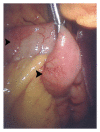Acute eosinophilic ascites in a middle-aged man
- PMID: 22649743
- PMCID: PMC3356866
- DOI: 10.1155/2012/896523
Acute eosinophilic ascites in a middle-aged man
Abstract
Eosinophilic gastroenteritis is a rare condition characterized by recurrent eosinophilic infiltration of portions of the GI tract and presenting with nonspecific GI symptoms in association with peripheral eosinophilia. Its etiology and pathogenesis remain unclear and its symptoms overlap with many GI and systemic diseases. Thus, both gastroenterologists and general internists need to be aware of this rare condition. We present a case of a 55-year-old male with diffuse abdominal pain and distention for two weeks. His physical examination was significant for moderate ascites. Initial work-up demonstrated severe peripheral blood eosinophilia, normal liver function tests, thickening of the stomach and small bowel wall, and elevated serum IgE. Upper endoscopy and extensive testing for malignancy and parasitic infections failed to establish a diagnosis. Ascitic fluid analysis showed significant eosinophilia. Further, a full-thickness jejunal showed marked eosinophilic infiltration of the serosa and muscularis propria. Subsequent treatment with oral prednisone resulted in normalization of laboratory and radiologic abnormalities in a few week period.
Figures





Similar articles
-
Eosinophilic ascites: A case report and literature review.J Family Community Med. 2015 Sep-Dec;22(3):183-5. doi: 10.4103/2230-8229.163042. J Family Community Med. 2015. PMID: 26392801 Free PMC article.
-
Eosinophilic ascites as an uncommon presentation of eosinophilic gastroenteritis: A case report.Arab J Gastroenterol. 2021 Jun;22(2):184-186. doi: 10.1016/j.ajg.2021.02.002. Epub 2021 Jun 2. Arab J Gastroenterol. 2021. PMID: 34090834
-
A Case of Eosinophilic Gastroenteritis Associated with Eosinophilic Ascites Diagnosed by Full-Thickness Biopsy of the Small Intestine.Am J Case Rep. 2019 Feb 13;20:189-193. doi: 10.12659/AJCR.913319. Am J Case Rep. 2019. PMID: 30755542 Free PMC article.
-
Eosinophilic gastroenteritis presenting as small bowel obstruction: a case report and review of the literature.World J Gastroenterol. 2007 Mar 21;13(11):1758-60. doi: 10.3748/wjg.v13.i11.1758. World J Gastroenterol. 2007. PMID: 17461485 Free PMC article. Review.
-
Causes of eosinophilic ascites - A systematic review.Rom J Intern Med. 2019 Jun 1;57(2):110-124. doi: 10.2478/rjim-2018-0041. Rom J Intern Med. 2019. PMID: 30864403
Cited by
-
Eosinophilic gastroenteritis in an adolescent male with history of chronic bullous disease.BMJ Case Rep. 2021 Feb 4;14(2):e238532. doi: 10.1136/bcr-2020-238532. BMJ Case Rep. 2021. PMID: 33541980 Free PMC article.
-
Ascites in a Young Woman: A Rare Presentation of Eosinophilic Gastroenteritis.Case Rep Gastrointest Med. 2018 May 10;2018:1586915. doi: 10.1155/2018/1586915. eCollection 2018. Case Rep Gastrointest Med. 2018. PMID: 29862093 Free PMC article.
References
-
- Agostino A, Parenzi A. Eosinophilic gastroenteritis. A case with predominant involvement of mucosal and muscular layers. Minerva Medica. 1994;85(12):655–658. - PubMed
-
- Klein NC, Hargrove RL, Sleisenger MH, Jeffries GH. Eosinophilic gastroenteritis. Medicine. 1970;49(4):299–319. - PubMed
-
- Lee M, Hodges WG, Huggins TL, Lee EL. Eosinophilic gastroenteritis. Southern Medical Journal. 1996;89(2):189–194. - PubMed
-
- Durieu I, Nove-Josserand R, Cathebras P, Vital Durand D, Rousset H, Levrat R. Eosinophilic ascites. Report of two cases. Revue de Medecine Interne. 1992;13(6):446–448. - PubMed
Publication types
LinkOut - more resources
Full Text Sources

